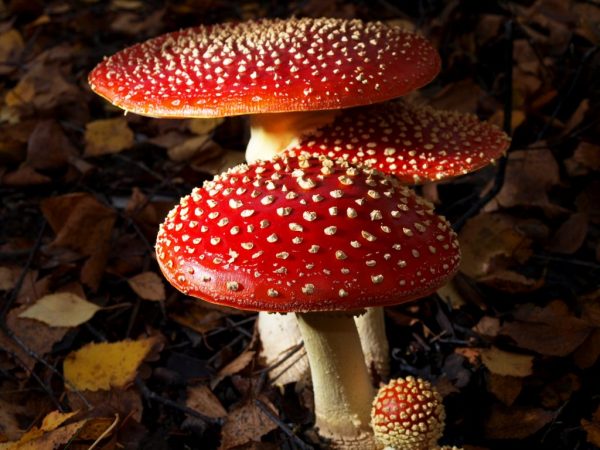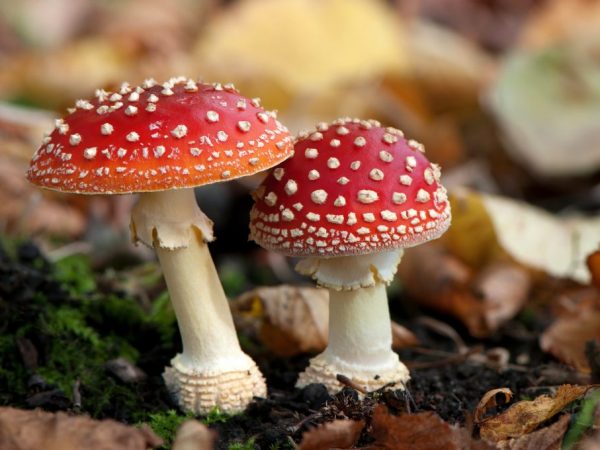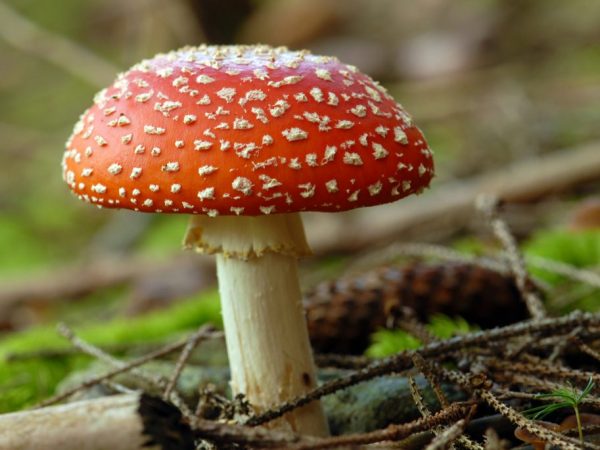Description of mushroom mushroom
One of the most poisonous representatives, the Amanita mushroom, is distributed throughout the globe. Refers to hallucinogenic varieties. Amanita can be poisoned, symptoms appear 15 minutes after eating.

Description of the mushroom Amanita
Description of appearance
Amanita is a poisonous mushroom. It was named after the old way of baiting flies. The name of the species "Muscaria" is translated as "fly".
The hat of a young fly agaric is convex, as it grows up it becomes flat, less often it takes the shape of a saucer, concave in the central part, the diameter of which is 8-25 cm. The color is bright orange or red. More often covered with a slimy sticky secretion. In North America, fly agarics with white and yellow caps are found. White flakes are located all over the surface. In older specimens, the points are washed away by precipitation. These flakes are the remnants of a common blanket in which the young fruiting body of the fungus was located.
At the edges, the surface of the cap is ribbed, striped - it has such an appearance due to the fact that the plates of the hymenophore are visible. The hymenophore is tubular, white in young hymenomycetes, yellowish in old ones. The leg is cylindrical in shape, growing from 8 to 20 cm in height. There is a tuberous thickening at the base. As they grow older, the leg becomes hollow inside. Filmy rings with uneven edges, formed in the form of wide shuttlecocks, are clearly visible in the upper part and below.
The flesh is white, just under the skin is pale orange in color. Upon reaction with air, the color of the pulp changes. The taste is sweetish, the smell is barely perceptible. Propagated by spore powder. The spores themselves are smooth and colorless.
Fly agarics grow in a coniferous or deciduous forest, the first representatives appear in May.
Views
The international classification includes several types of fly agarics, which differ in structural features, color, origin, and the degree of toxicity.
- Amanita muscaria (Amanita muscaria): grows in Eurasia and western Alaska. The color of the cap of the fly agaric is red, with characteristic warty growths of white.
- Fly agaric yellow-orange (Amanita gemmata): the variety is distinguished by a yellow or orange cap. The pulp is firm, white, does not change color when in contact with air. The leg is straight, cylindrical, white. Grows in North America. Dangerous to humans and animals.
- Amanita muscaria (Amanita muscaria var.aureola): a leg-cap representative, dangerous to humans. It features a smooth orange cap without warty flakes. The diametral area of the cap is not more than 5 cm.
- Pineal fly agaric (Amanita strobiliformis): the bright red cap becomes flat with age, reaches 5-25 cm in diameter. The type of m. cone-shaped is similar to the Caesar mushroom.
- Fly agaric leopard or panther (Amanita pantherina): poisonous, has a pleasant aroma. Outwardly, it looks like a gray-pink edible fly agaric. Grows in coniferous forests. The cap reaches 9 cm in diameter. It is painted gray-brown or brown-black.
- Fly agaric toadstool or lemon (Amanita citrina): classified as inedible. It is characterized by the taste of raw potatoes and an unpleasant odor. Eating it in food causes indigestion and causes significant damage to the kidneys.
- Fly agaric gray-pink or pinkish (Amanita rubescens): not appetizing, but completely edible. The cap reaches 18 cm in diameter, hemispherical. The surface is pale, with a pink tint, covered with a large number of warty gray dots. The lamellar hymenophore is pale green in the young mushroom, and pink in the old one. The pulp is fleshy, thick, white or pale pink, after a while the cut turns red.
Irina Selyutina (Biologist):
The fruiting bodies of the gray-pink fly agaric contain a number of useful substances:
- about 40% of phosphate compounds useful for humans;
- about 5% betaine (the presence of which is also determined in beet roots);
- 12.8 mg vitamin B1 and 12.8 mg vitamin B2 (per 1 kg of dry weight).
However, for fear of confusing it with similar poisonous species, the pink fly agaric is rarely eaten.
- Amanita caesarea (Amanita caesarea): the most delicious edible counterpart of fly agarics, a real delicacy. The size of the cap is 8-21 cm. The skin is golden-orange or bright red, occasionally yellowish representatives are found in nature. The plates under the cap are colored green. A skirt is clearly visible on the leg from below.
Beneficial features

Mushrooms are used in medicine
The red and panther fly agaric are endowed with healing properties, therefore they are used in folk medicine.
Toxicological composition of the fly agaric:
- poisonous alkaloid muscarine;
- muscaridin;
- mycoatropine;
- psilocybin;
- muscimol;
- ibotenic acid;
- muscarufin.
Irina Selyutina (Biologist):
In our human culture, there is a common name for mushrooms that can cause an altered state of the psyche based on the special compounds contained in their fruit bodies - hallucinogens. These are hallucinogenic or magic mushrooms. A study of a number of sources has shown that one of the most widespread species in the territory of the post-Soviet space - the red fly agaric 3500 years ago was used for these purposes among the tribes inhabiting the Far North. It has long been established that the regular use of such mushrooms leads to a mental disorder, and then to the complete destruction and physical degradation of the personality.
The alkaloid muscarine is classified as a strong poison. The use of 0.005 g causes hallucinations, gives complications to all internal organs, up to and including death. The dosage of muscarine during treatment should be minimal. The lethal dose is 3-5 mg. When using poisonous basidiomycetes, the age of a person matters: for children and elderly people, the lethal dose of muscarine is 1-2 mg.
Contraindications
Take tinctures and medicines based on extract from Amanita should be with caution. Due to their specificity (the presence of toxins in the composition), drugs are not used to treat pregnant, lactating women and children. Most often, drugs are used externally, because alcoholic tinctures provoke poisoning, cause hallucinogenic effects.
It is contraindicated for people suffering from urolithiasis, gastric disorders, neuroses. Symptoms of poisoning are neutralized by drinking 15 drops of Belladonna's medicinal collection. Having noticed the first signs of poisoning, before the ambulance arrives, you need to quickly cleanse the body by causing vomiting and drink more water.
Application
The poisonous representative of hymenomycetes is striking in its properties. The toxicity is neutralized by heat treatment. After 3-4 times boiling, the product is dried and then used for its intended purpose. Only hats are suitable for the production of tinctures, they do not take them with bare hands, they work with gloves.
Interesting facts about the use of fly agaric:
- used to get rid of flies: sweet syrup was applied to the caps, on which pests flocked;
- the Vikings used tinctures to gain fearlessness, to turn off sensitivity: the medicinal properties of the tincture helped to get rid of severe pain after severe wounds;
- healers used it to relieve toothache;
- there is evidence that shamans took the infusion to put themselves into a trance and achieve nirvana;
- fly agaric ointment during ancient Egypt was used in cosmetology as a remedy for wrinkles;
- resourceful Japanese have learned to use poisonous varieties in food, passing on secret recipes from generation to generation;
- a poisoned elk tries to find a fly agaric in the forest: it helps to recover from poisoning and has a slight "laughing" effect - having eaten the meat of such an animal, a person will also feel the "laughing" effect.
Used in the treatment of spring mushroom. During this period, a sufficient amount of precipitation falls, so the toxicity of the mushroom body is much lower. The meadow for collecting medicinal mushrooms must be located in a place far from the road. These mushrooms, like other basidiomycetes, have the ability to absorb toxins from the environment in hot weather.
The product heals not only animals and people, but also plants. Spore powder is used in agriculture for the production of fertilizers and fungicides. The pharmacy sells a balm called: Amanita Fungo-Shi. It is used strictly according to the recipe.
In cooking

There are edible types of amanita
You can eat only edible varieties of pink-colored fly agaric and Caesar fly agaric. They are distinguished by their high taste characteristics. Before use, be sure to clean and boil several times.
Various culinary delights are prepared with their use. They are equally good marinated, salted and fried. The dried hats are used to make delicious soups. An interesting gourmet salad can be prepared by mixing pickled Caesar, boiled squid, quail eggs and mayonnaise.
The benefits of their use are invaluable for the body. Caesar mushroom contains a large amount of protein and minerals that help strengthen the body. It is used in dietetic food. It is a complete substitute for meat.
In medicine
Amanita is widely used in medicine. They are used to treat sciatica, stimulate the immune system. External remedies are used in the treatment of abscesses, joint diseases, inflammation of the sciatic nerves, as the prevention of cancer, leukemia.
Amanita in the treatment of oncology is used as an anesthetic. A small amount of tincture, taken internally, has an antidepressant-like effect.
Amanita is useful for men suffering from prostatitis, and also as an aphrodisiac. External application (rubbing) allows you to eliminate the consequences of tuberculosis, has a positive effect on the condition of the lungs. It is actively used against skin diseases (psoriasis, eczema), for the healing of wound surfaces with the presence of a secondary infection. The medicinal properties of the product are used in cosmetology. Antibacterial soap is made from it.
Conclusion
Poisonous fly agaric species have been known to people for their medicinal properties for a long time. The origin of the name is associated with the ancient method of their use in the destruction of insect pests on the territory of the personal plot. The extract is used in pharmacology. The use of tincture is useful for cancer patients and people suffering from joint pain.
Amanita muscaria is able to provide a kind of "amusing" effect. Increasing the prescribed dosage of the medication taken by mouth will cause signs of poisoning.



